China and Covid19
‘Little Sheep People’: The Stigmatization of Covid Patients in China
Has testing negative or positive for Covid become a matter of ‘good’ versus ‘evil’?
Published
2 years agoon
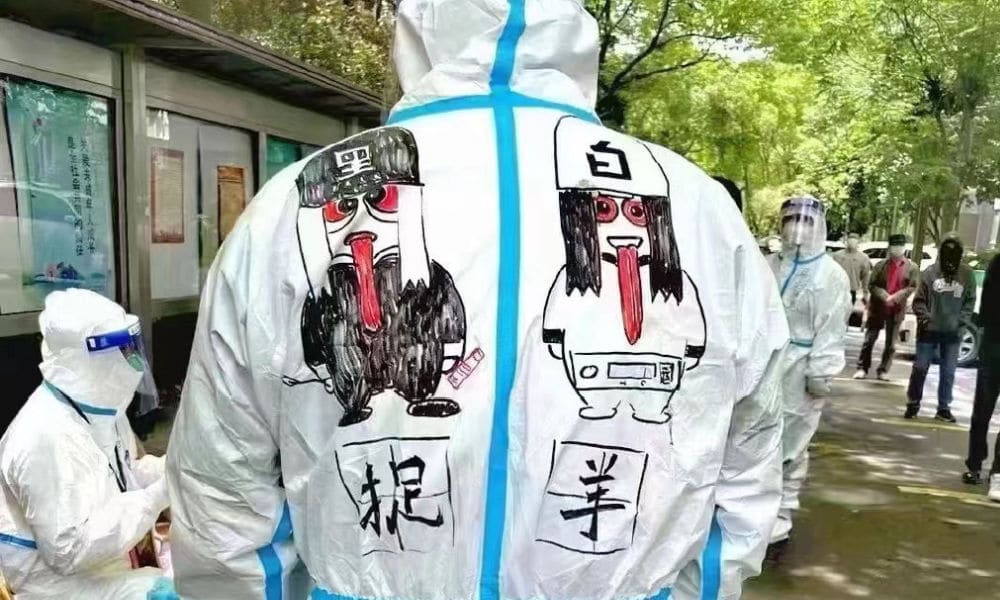
PREMIUM CONTENT
As many people face Covid-related discrimination in China after testing positive, social media users are now speaking out against popular (online) language that refers to Covid patients as ‘sheep,’ saying the way people talk about the virus is worsening existing stigmatization.
As Shanghai is entering its sixth week of citywide Covid lockdowns, there have been over 60,000 confirmed cases of Covid, and more than 52,000 people have recovered. Meanwhile, other cities in China, including Beijing and Zhengzhou, are also seeing Covid cases rise.
Everyone who tests positive for Covid in China currently needs to go to a centralized quarantine location to ‘recover,’ even if they have no symptoms. Covid-19 patients are not allowed to isolate at home due to the risk of spreading the virus or developing severe illness.
Patients who have been discharged from quarantine locations do not always receive a warm welcome upon returning back to their community. They need to test negative for Covid twice in a row before being discharged, but then often face discrimination from neighbors or family members who fear they might still carry the virus.
In online conversations, people who have tested positive for Covid are also referred to as “little positive people” (小阳人). But because the Chinese (Mandarin) word for ‘positive’ (yáng 阳) has the same pronunciation as the word for ‘sheep’ (yáng 羊), the meaning has come to shift, going from ‘little positive people’ to ‘little sheep persons’ (小羊人).
Gradually, Covid patients have also started to be labeled as “two-legged sheep” (liǎngjiǎoyáng 两脚羊), with male patients sometimes referred to as rams (gōngyáng 公羊) and female patients as ewes (mǔyáng 母羊). On social media, netizens also simply use the emoticon for a sheep (🐑) to refer to Covid-positive people.
“Stop calling Covid patients ‘little sheep’!”
A recent WeChat article by the health and medical platform Dxy.com describes the trend of referring to Covid patients as ‘little sheep’ stigmatizing and disrespectful, calling on people to stop labeling (recovered) Covid patients like this (DXY 2022).
The article suggests it is harmful to discriminate against Covid patients, comparing the language that is being used to describe Covid patients to how people affected by leprosy have suffered stigma and discrimination throughout history.
Using the hashtag “Stop Calling Covid Patients ‘Little Sheep [Positive] People'” (#别再叫新冠患者小阳人了#), Weibo users are discussing the stigmatization of people with Covid, with many agreeing that the language used to talk about Covid patients needs to change.
“This is no different than when other countries talked about the ‘Wuhan virus’ at the start of the pandemic,” one commenter wrote. “I always felt puzzled when people would use ‘sheep’ to talk about infected people, it’s so disrespectful,” another person replied. “People are people, with feelings and dignity, it’s just inhumane to refer to them as ‘two-legged sheep.'”
In April, another online article – including a conversation with a Shanghai Disease Control and Prevention doctor – also pointed out the problem of Chinese Covid patients being stigmatized. Popular science author Wang Jie (汪诘), who is based in Shanghai, wrote that the misunderstanding and panic about the virus are actually more frightening than Covid itself and that the disdain for Covid patients is most harmful to them.
The article was controversial and ended up being taken offline from Wechat, mainly because Wang Jie stressed that in the midst of China’s zero-Covid policy and the Shanghai outbreak, the ‘cure’ against the wave of Covid infections seemed to be worse than the virus itself. In doing so, Wang also addressed that the way Covid patients are being treated is often based on fear and panic rather than science.
All of the panic surrounding the virus has placed those who are positive or even recovered under scrutiny. China’s low infection rates have also made persons who have tested positive for Covid an anomaly to many, and there is the simple fear the virus might be transmitted to them or their loved ones – a risk that would affect their family and might even have consequences for the entire community they live in.
In early stages of a local outbreak, some of the people who were among the first to test positive were also referred to as ‘spreaders’ (放毒). In many cases, their contact tracing records were made public to inform residents, leading to the entire country knowing a person’s recent whereabouts (in one case, this exposed the tragic story of a Beijing migrant).
“When did testing positive become a social problem, and not just a medical one?”
Despite using different vocabulary, Chinese state media reports on how to deal with discharged patients perhaps also do not help in fighting the Covid stigma. In April, Shanghai Daily reminded people that recovered Covid-19 patients won’t infect others after returning home, but at the same time, it also suggested that recovered patients should live in well-ventilated rooms alone and avoid close contact and meals with their family members, while also reducing contact with other residents in the community (Yang 20220).
The official guidelines for recovered Covid patients in Shanghai require seven-day home health testing (check temperature twice a day, another nucleic acid test on the seventh day), and also prescribe people to stay isolated at home in a room by themselves and keeping a safe distance from others.
“I talked to my neighbor who came back from the quarantine hospital. He said he felt that people were avoiding him, that he was discriminated against and getting stared at. He worried about how this might mentally hurt his daughter, afraid that others wouldn’t play with her anymore,” one Weibo commenter named ‘Walexandraw’ shared.
Another social media user nicknamed ‘Love is Torture’ wrote that the community where they lived did not allow them back in after returning from the quarantine facility, forcing them to stay at their company’s dormitory instead: “So what use is the government proof of recovery? Is it nothing but a piece of paper? I have a home I can’t return to, is this the correct way to handle things?!”
Recently, a photo showing a drawing on the back of the hazmat suit of an anti-epidemic worker also triggered some controversy online. The drawing shows a black and a white figure, and underneath it says “grabbing sheep” (捉羊).
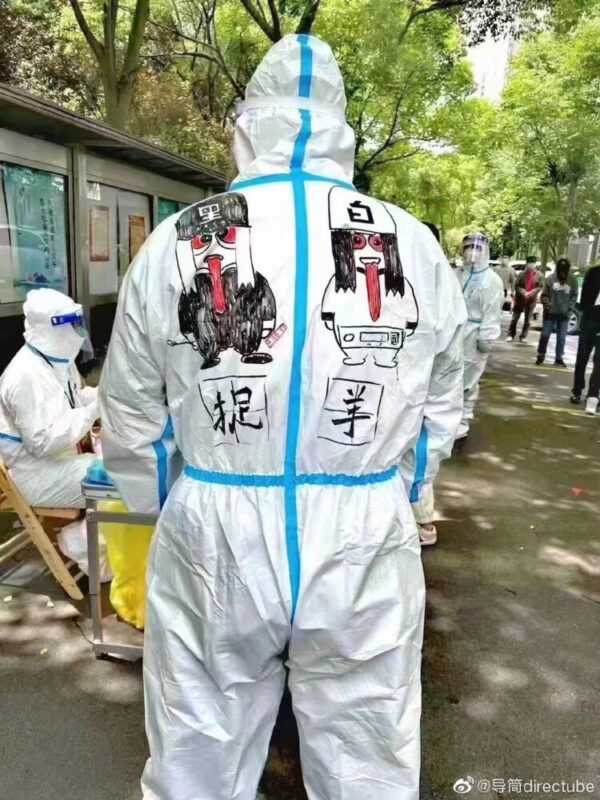
The picture is based on Heibai Wuchang (黑白无常), two Chinese folk religion deities – the Black and White Guard, sometimes represented as one single person – in charge of escorting spirits of the dead to the underworld. Persons doing good will meet the deity of fortune, while persons committing evil will meet the malevolent deity (Eng 2019).
Many people condemned the drawing for the message it conveyed of wrong versus right, with the ‘sheep’ testing positive for Covid going to ‘hell.’ Some mentioned that this kind of objectification of people could contribute to a Lucifer effect where anti-epidemic workers actually start to internalize ideas about the people they are testing in terms of ‘grabbing sheep’ and ‘good versus evil.’
“This person is objectifying patients by referring to them as ‘sheep’ and using the Heibai Wuchang drawing along with it, really making people uncomfortable,” one person wrote, with another Weibo user commenting:
“Since when do you have to feel inferior and guilty about it all being your own fault if you get the virus? When did testing positive become a social problem, and not just a medical one? Why not give positive patients a respectful name instead of a wrong one like ‘little sheep person’?”
Weibo blogger ‘Directube’ also posted another digital art work highlighting this idea of medical workers fighting against the evil of Covid.
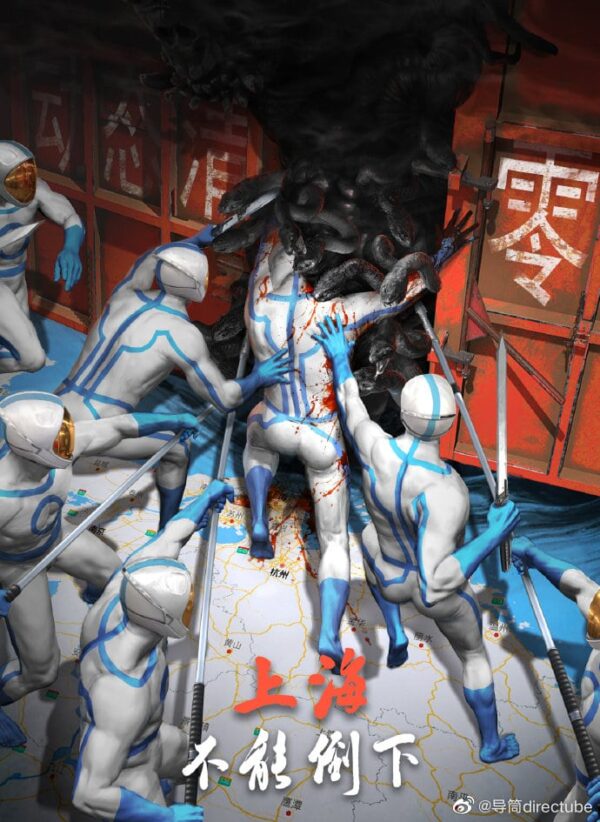
“Is this 2022 or 1822?” one person wondered.
Despite all the online calls to change the popular language related to Covid (“language is a tool for thought and shapes what we think all the time), there are also many netizens who find the nicknames funny and innocent, and continue to call Covid patients ‘little sheep’ and other related terms.
“I just thought the term was cute,” one person writes, with another netizen complaining: “We have another little sheep in the community – we’re in lockdown again.”
For more articles on the Covid-19 topics on Chinese social media, check here.
By Manya Koetse, with contributions by Miranda Barnes
Get the story behind the hashtag. Subscribe to What’s on Weibo here to receive our weekly newsletter and get access to our latest articles:
References
DXY.com. 2022. “别再叫新冠患者「小阳人」了 [“Don’t Call Covid Patients Little Sheep]” (In Chinese). Dingxiang Yisheng 丁香医生 WeChat Account, May 6 https://mp.weixin.qq.com/s/XbqZpi0PlP55RFe8RLV_1g [May 7 2022].
Eng, Khoo Boo. 2019. Understanding Chinese Culture in Relation to Tao. Singapore: Partridge Publishing.
Yang, Jian. 2022. “11,000 Patients Discharged after Recovery.” Shanghai Daily 23 (7496), April 11.
Wang Jie 汪诘. 2022. “比新冠病毒更可怕的,是对病毒的误解和恐慌 [What Is More Frightening Than the Novel Coronavirus Is the Misunderstanding and Panic about the Virus]” (In Chinese). Sohu.com, April 3 https://www.sohu.com/a/535112126_120083328 [May 7 2022].
Spotted a mistake or want to add something? Please let us know in comments below or email us. First-time commenters, please be patient – we will have to manually approve your comment before it appears.
©2022 Whatsonweibo. All rights reserved. Do not reproduce our content without permission – you can contact us at info@whatsonweibo.com.
Manya Koetse is the founder and editor-in-chief of whatsonweibo.com. She is a writer, public speaker, and researcher (Sinologist, MPhil) on social trends, digital developments, and new media in an ever-changing China, with a focus on Chinese society, pop culture, and gender issues. She shares her love for hotpot on hotpotambassador.com. Contact at manya@whatsonweibo.com, or follow on Twitter.

China and Covid19
Sick Kids, Worried Parents, Overcrowded Hospitals: China’s Peak Flu Season on the Way
“Besides Mycoplasma infections, cases include influenza, Covid-19, Norovirus, and Adenovirus. Heading straight to the hospital could mean entering a cesspool of viruses.”
Published
8 months agoon
November 22, 2023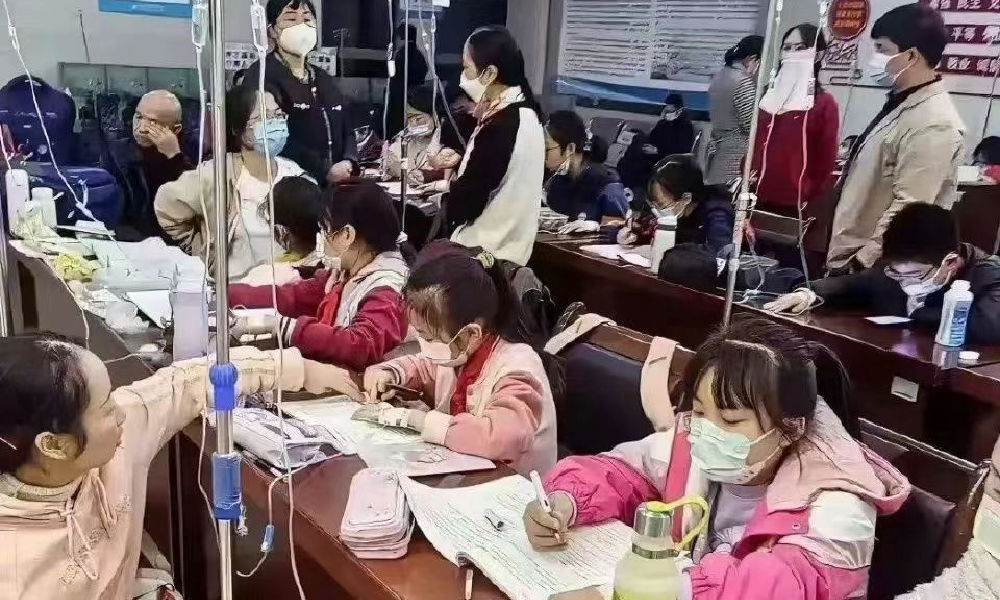
In the early morning of November 21, parents are already queuing up at Xi’an Children’s Hospital with their sons and daughters. It’s not even the line for a doctor’s appointment, but rather for the removal of IV needles.
The scene was captured in a recent video, only one among many videos and images that have been making their rounds on Chinese social media these days (#凌晨的儿童医院拔针也要排队#).
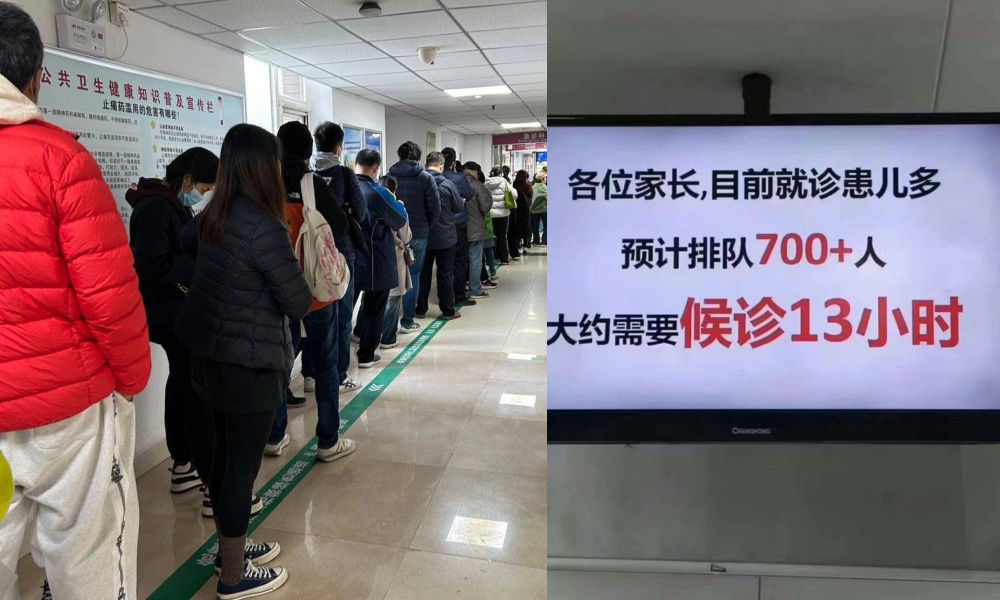
One photo shows a bulletin board at a local hospital warning parents that over 700 patients are waiting in line, estimating a waiting time of more than 13 hours to see a doctor.
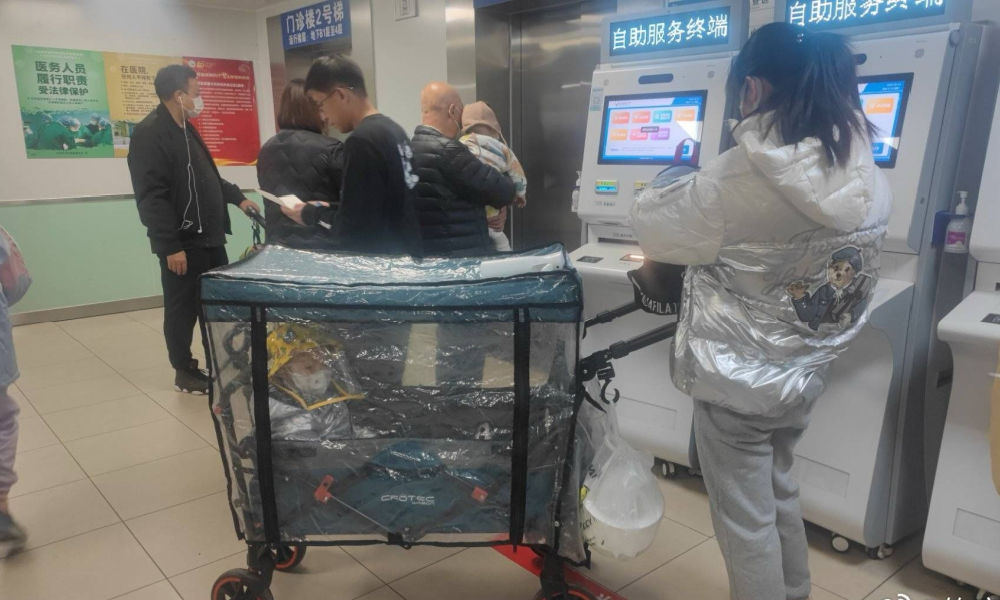
Another image shows children doing their homework while hooked up on an IV.
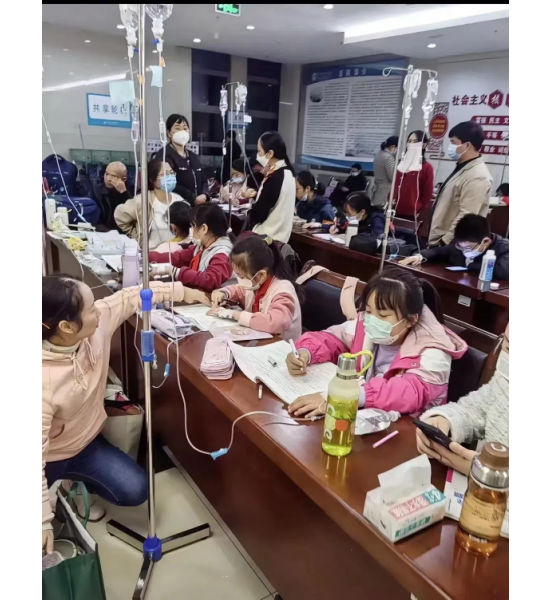
Recent discussions on Chinese social media platforms have highlighted a notable surge in flu cases. The ongoing flu season is particularly impacting children, with multiple viruses concurrently circulating and contributing to a high incidence of respiratory infections.
Among the prevalent respiratory infections affecting children are Mycoplasma pneumoniae infections, influenza, and Adenovirus infection.
The spike in flu cases has resulted in overcrowded children’s hospitals in Beijing and other Chinese cities. Parents sometimes have to wait in line for hours to get an appointment or pick up medication.
According to one reporter at Haibao News (海报新闻), there were so many patients at the Children’s Hospital of Capital Institute of Pediatrics (首都儿科研究所) on November 21st that the outpatient desk stopped accepting new patients by the afternoon. Meanwhile, 628 people were waiting in line to see a doctor at the emergency department.
Reflecting on the past few years, the current flu season marks China’s first ‘normal’ flu peak season since the outbreak of Covid-19 in late 2019 / early 2020 and the end of its stringent zero-Covid policies in December 2022. Compared to many other countries, wearing masks was also commonplace for much longer following the relaxation of Covid policies.
Hu Xijin, the well-known political commentator, noted on Weibo that this year’s flu season seems to be far worse than that of the years before. He also shared that his own granddaughter was suffering from a 40 degrees fever.
“We’re all running a fever in our home. But I didn’t dare to go to the hospital today, although I want my child to go to the hospital tomorrow. I heard waiting times are up to five hours now,” one Weibo user wrote.
“Half of the kids in my child’s class are sick now. The hospital is overflowing with people,” another person commented.
One mother described how her 7-year-old child had been running a fever for eight days already. Seeking medical attention on the first day, the initial diagnosis was a cold. As the fever persisted, daily visits to the hospital ensued, involving multiple hours for IV fluid administration.
While this account stems from a single Weibo post within a fever-advice community, it highlights a broader trend: many parents swiftly resort to hospital visits at the first signs of flu or fever. Several factors contribute to this, including a lack of General Practitioners in China, making hospitals the primary choice for medical consultations also in non-urgent cases.
There is also a strong belief in the efficacy of IV infusion therapy, whether fluid-based or containing medication, as the quickest path to recovery. Multiple factors contribute to the widespread and sometimes irrational use of IV infusions in China. Some clinics are profit-driven and see IV infusions as a way to make more money. Widespread expectations among Chinese patients that IV infusions will make them feel better also play a role, along with some physicians’ lacking knowledge of IV therapy or their uncertainty to distinguish bacterial from viral infections (read more here)
To prevent an overwhelming influx of patients to hospitals, Chinese state media, citing specialists, advise parents to seek medical attention at the hospital only for sick infants under three months old displaying clear signs of fever (with or without cough). For older children, it is recommended to consult a doctor if a high fever persists for 3 to 5 days or if there is a deterioration in respiratory symptoms. Children dealing with fever and (mild) respiratory symptoms can otherwise recover at home.
One Weibo blogger (@奶霸知道) warned parents that taking their child straight to the hospital on the first day of them getting sick could actually be a bad idea. They write:
“(..) pediatric departments are already packed with patients, and it’s not just Mycoplasma infections anymore. Cases include influenza, Covid-19, Norovirus, and Adenovirus. And then, of course, those with bad luck are cross-infected with multiple viruses at the same time, leading to endless cycles. Therefore, if your child experiences mild coughing or a slight fever, consider observing at home first. Heading straight to the hospital could mean entering a cesspool of viruses.”
The hashtag for “fever” saw over 350 million clicks on Weibo within one day on November 22.
Meanwhile, there are also other ongoing discussions on Weibo surrounding the current flu season. One topic revolves around whether children should continue doing their homework while receiving IV fluids in the hospital. Some hospitals have designated special desks and study areas for children.
Although some commenters commend the hospitals for being so considerate, others also remind the parents not to pressure their kids too much and to let them rest when they are not feeling well.
Opinions vary: although some on Chinese social media say it's very thoughtful for hospitals to set up areas where kids can study and read, others blame parents for pressuring their kids to do homework at the hospital instead of resting when not feeling well. pic.twitter.com/gnQD9tFW2c
— Manya Koetse (@manyapan) November 22, 2023
By Manya Koetse, with contributions from Miranda Barnes
Get the story behind the hashtag. Subscribe to What’s on Weibo here to receive our newsletter and get access to our latest articles:
Spotted a mistake or want to add something? Please let us know in comments below or email us. First-time commenters, please be patient – we will have to manually approve your comment before it appears.
©2023 Whatsonweibo. All rights reserved. Do not reproduce our content without permission – you can contact us at info@whatsonweibo.com.
China and Covid19
Repurposing China’s Abandoned Nucleic Acid Booths: 10 Innovative Transformations
Abandoned nucleic acid booths are getting a second life through these new initiatives.
Published
1 year agoon
May 19, 2023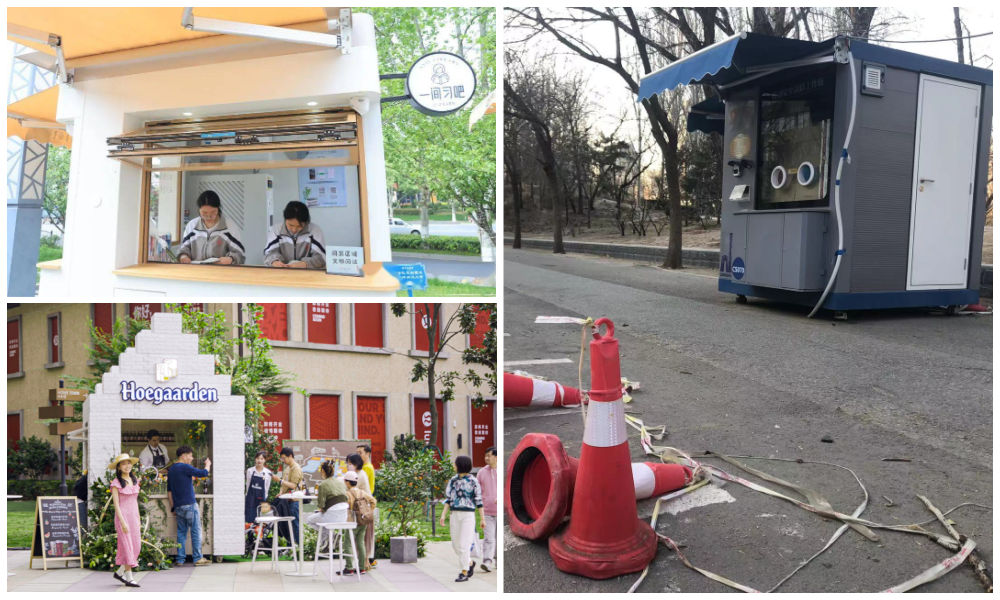
During the pandemic, nucleic acid testing booths in Chinese cities were primarily focused on maintaining physical distance. Now, empty booths are being repurposed to bring people together, serving as new spaces to serve the community and promote social engagement.
Just months ago, nucleic acid testing booths were the most lively spots of some Chinese cities. During the 2022 Shanghai summer, for example, there were massive queues in front of the city’s nucleic acid booths, as people needed a negative PCR test no older than 72 hours for accessing public transport, going to work, or visiting markets and malls.
The word ‘hésuān tíng‘ (核酸亭), nucleic acid booth (also:核酸采样小屋), became a part of China’s pandemic lexicon, just like hésuān dìtú (核酸地图), the nucleic acid test map lauched in May 2022 that would show where you can get a nucleic test.
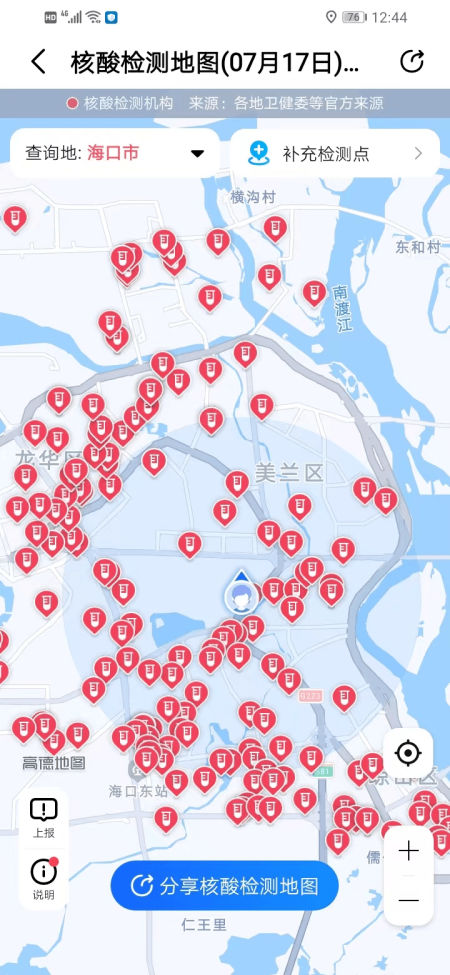
Example of nucleic acid test map.
During Halloween parties in Shanghai in 2022, some people even came dressed up as nucleic test booths – although local authorities could not appreciate the creative costume.
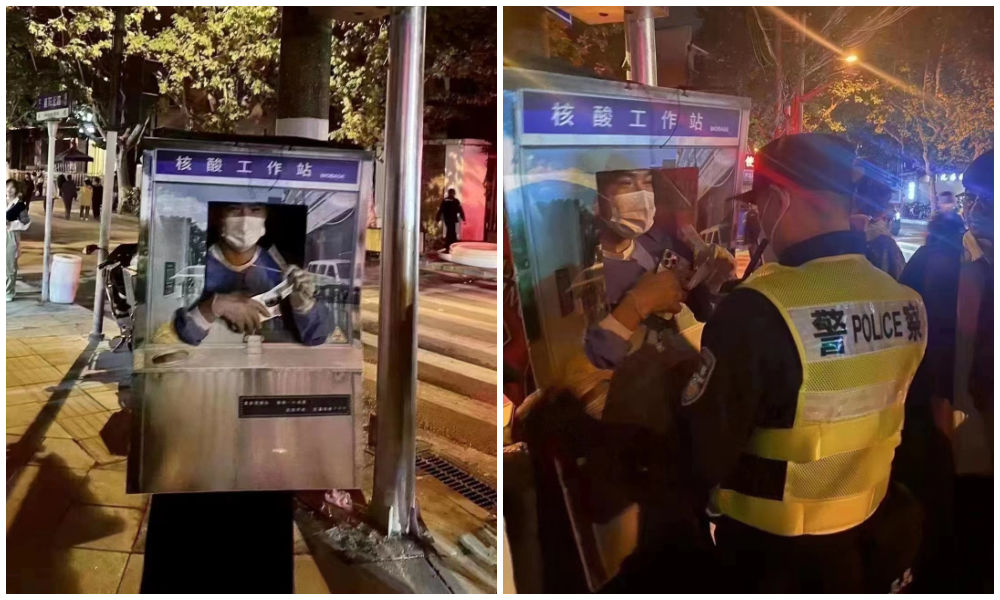
Halloween 2022: dressed up as nucliec acid booths. Via @manyapan twitter.
In December 2022, along with the announced changed rules in China’s ‘zero Covid’ approach, nucleic acid booths were suddenly left dismantled and empty.
With many cities spending millions to set up these booths in central locations, the question soon arose: what should they do with the abandoned booths?
This question also relates to who actually owns them, since the ownership is mixed. Some booths were purchased by authorities, others were bought by companies, and there are also local communities owning their own testing booths. Depending on the contracts and legal implications, not all booths are able to get a new function or be removed yet (Worker’s Daily).
In Tianjin, a total of 266 nucleic acid booths located in Jinghai District were listed for public acquisition earlier this month, and they were acquired for 4.78 million yuan (US$683.300) by a local food and beverage company which will transform the booths into convenience service points, selling snacks or providing other services.
Tianjin is not the only city where old nucleic acid testing booths are being repurposed. While some booths have been discarded, some companies and/or local governments – in cooperation with local communities – have demonstrated creativity by transforming the booths into new landmarks. Since the start of 2023, different cities and districts across China have already begun to repurpose testing booths. Here, we will explore ten different way in which China’s abandoned nucleic test booths get a second chance at a meaningful existence.
1: Pharmacy/Medical Booths
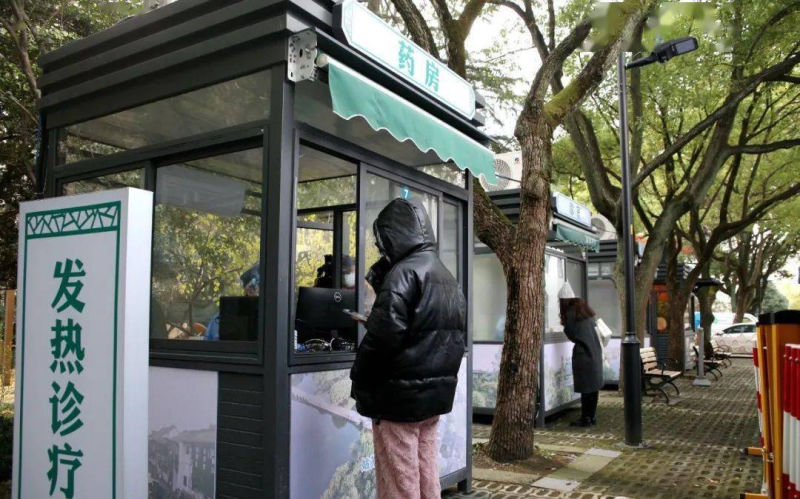
Via ‘copyquan’ republished on Sohu.
Blogger ‘copyquan’ recently explored various ways in which abandoned PCR testing points are being repurposed.
One way in which they are used is as small pharmacies or as medical service points for local residents (居民医疗点). Alleviating the strain on hospitals and pharmacies, this was one of the earliest ways in which the booths were repurposed back in December of 2022 and January of 2023.
Chongqing, Tianjin, and Suzhou were among earlier cities where some testing booths were transformed into convenient medical facilities.
2: Market Stalls
In Suzhou, Jiangsu province, the local government transformed vacant nucleic acid booths into market stalls for the Spring Festival in January 2022, offering them free of charge to businesses to sell local products, snacks, and traditional New Year goods.
The idea was not just meant as a way for small businesses to conveniently sell to local residents, it was also meant as a way to attract more shoppers and promote other businesses in the neighborhood.
3: Community Service Center
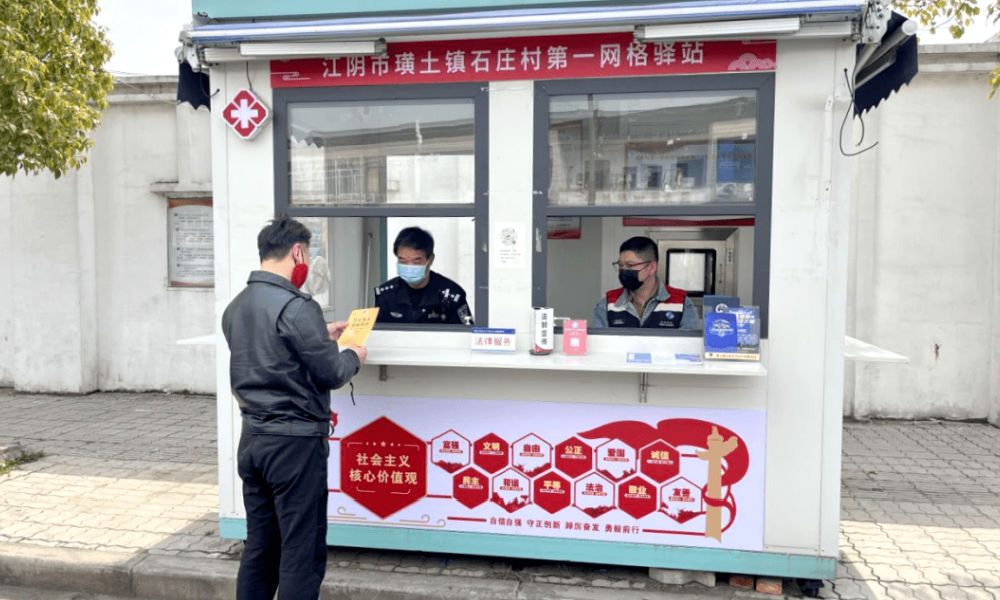
Small grid community center in Shizhuang Village, image via Sohu.
Some residential areas have transformed their local nucleic acid testing booths into community service centers, offering all kinds of convenient services to neighborhood residents.
These little station are called wǎnggé yìzhàn (网格驿站) or “grid service stations,” and they can serve as small community centers where residents can get various kinds of care and support.
4: “Refuel” Stations

In February of this year, 100 idle nucleic acid sampling booths were transformed into so-called “Rider Refuel Stations” (骑士加油站) in Zhejiang’s Pinghu. Although it initially sounds like a place where delivery riders can fill up their fuel tanks, it is actually meant as a place where they themselves can recharge.
Delivery riders and other outdoor workers can come to the ‘refuel’ station to drink some water or tea, warm their hands, warm up some food and take a quick nap.
5: Free Libraries

image via sohu.
In various Chinese cities, abandoned nucleic acid booths have been transformed into little free libraries where people can grab some books to read, donate or return other books, and sit down for some reading.
Changzhou is one of the places where you’ll find such “drifting bookstores” (漂流书屋) (see video), but similar initiatives have also been launched in other places, including Suzhou.
6: Study Space

Photos via Copyquan’s article on Sohu.
Another innovative way in which old testing points are being repurposed is by turning them into places where students can sit together to study. The so-called “Let’s Study Space” (一间习吧), fully airconditioned, are opened from 8 in the morning until 22:00 at night.
Students – or any citizens who would like a nice place to study – can make online reservations with their ID cards and scan a QR code to enter the study rooms.
There are currently ten study booths in Anji, and the popular project is an initiative by the Anji County Library in Zhejiang (see video).
7: Beer Kiosk

Hoegaarden beer shop, image via Creative Adquan.
Changing an old nucleic acid testing booth into a beer bar is a marketing initiative by the Shanghai McCann ad agency for the Belgium beer brand Hoegaarden.
The idea behind the bar is to celebrate a new spring after the pandemic. The ad agency has revamped a total of six formr nucleic acid booths into small Hoegaarden ‘beer gardens.’
8: Police Box

In Taizhou City, Jiangsu Province, authorities have repurposed old testing booths and transformed them into ‘police boxes’ (警务岗亭) to enhance security and improve the visibility of city police among the public.
Currently, a total of eight vacant nucleic acid booths have been renovated into modern police stations, serving as key points for police presence and interaction with the community.
9: Lottery Ticket Booths

Image via The Paper
Some nucleic acid booths have now been turned into small shops selling lottery tickets for the China Welfare Lottery. One such place turning the kiosks into lottery shops is Songjiang in Shanghai.
Using the booths like this is a win-win situation: they are placed in central locations so it is more convenient for locals to get their lottery tickets, and on the other hand, the sales also help the community, as the profits are used for welfare projects, including care for the elderly.
10: Mini Fire Stations

Micro fire stations, images via ZjNews.
Some communities decided that it would be useful to repurpose the testing points and turn them into mini fire kiosks, just allowing enough space for the necessary equipment to quickly respond to fire emergencies.
Want to read more about the end of ‘zero Covid’ in China? Check our other articles here.
By Manya Koetse,
Get the story behind the hashtag. Subscribe to What’s on Weibo here to receive our newsletter and get access to our latest articles:
Spotted a mistake or want to add something? Please let us know in comments below or email us. First-time commenters, please be patient – we will have to manually approve your comment before it appears.
©2023 Whatsonweibo. All rights reserved. Do not reproduce our content without permission – you can contact us at info@whatsonweibo.com.
Subscribe

Weibo Watch: The Future is Here

“Bye Bye Biden”: Biden’s Many Nicknames in Chinese

Enjoying the ‘Sea’ in Beijing’s Ditan Park

A Triumph for “Comrade Trump”: Chinese Social Media Reactions to Trump Rally Shooting

Weibo Watch: Get Up, Stand Up

The Tragic Story of “Fat Cat”: How a Chinese Gamer’s Suicide Went Viral

“Old Bull Eating Young Grass”: 86-Year-Old Chinese Painter Fan Zeng Marries 36-Year-Old Xu Meng

A Brew of Controversy: Lu Xun and LELECHA’s ‘Smoky’ Oolong Tea

Singing Competition or Patriotic Fight? Hunan TV’s ‘Singer 2024’ Stirs Nationalistic Sentiments

Zara Dress Goes Viral in China for Resemblance to Haidilao Apron

Weibo Watch: The Battle for the Bottom Bed

About the “AI Chatbot Based on Xi Jinping” Story

China’s Intensified Social Media Propaganda: “Taiwan Must Return to Motherland”

Weibo Watch: Telling China’s Stories Wrong

Saying Goodbye to “Uncle Wang”: Wang Wenbin Becomes Chinese Ambassador to Cambodia
Get in touch
Would you like to become a contributor, or do you have any tips or suggestions? Get in touch here!
Popular Reads
-

 China Insight3 months ago
China Insight3 months agoThe Tragic Story of “Fat Cat”: How a Chinese Gamer’s Suicide Went Viral
-

 China Music4 months ago
China Music4 months agoThe Chinese Viral TikTok Song Explained (No, It’s Not About Samsung)
-

 China Digital10 months ago
China Digital10 months agoToo Sexy for Weibo? Online Discussions on the Concept of ‘Cābiān’
-

 China Arts & Entertainment12 months ago
China Arts & Entertainment12 months agoBehind 8 Billion Streams: Who is Dao Lang Cursing in the Chinese Hit Song ‘Luocha Kingdom’?







